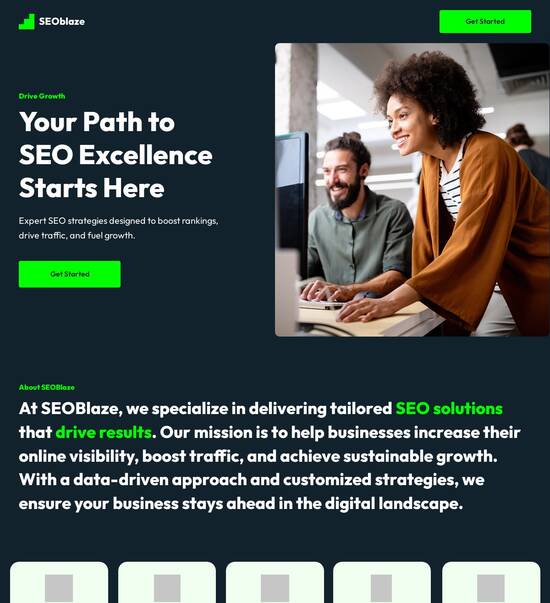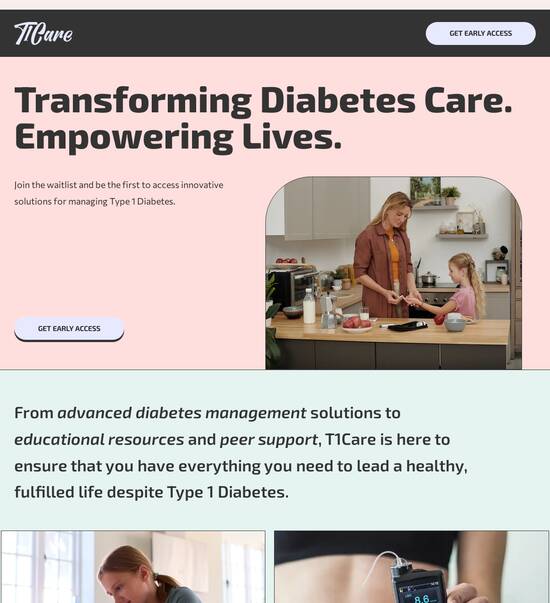
Web page template for Java architects
Use TemplateAbout template
Attract clients and showcase your skills with style using our landing page templates for Java architects. Let's convert those visitors into clients!
Recommended templates

Easy to build without coding
With the intuitive drag-and-drop builder, anyone on your team can create high-converting pages without any knowledge of code or design. Make enhancements to your landing page with custom widgets using Javascript, HTML/CSS, or third-party scripts.

Multiple layouts for any industry and goal
Select from 500+ landing page layouts built to boost conversions across industry-specific scenarios. Customize them by adjusting fonts, adding images, and generating on-brand content with the AI assistant. Quickly scale with Instablocks® and Global Blocks that you can save, reuse, and update globally.

Loads fast and looks polished on any device
Every template is responsive, which means they present professionally on any device and load blazingly fast with our Thor Render Engine. You can also power them up with Google AMP technology to deliver an unparalleled mobile experience and drive higher conversions.

Robust analytics & experimentation
Get real-time updates and reporting across all your devices, showing the number of visitors, conversions, cost-per-visitor, and cost-per-lead. Launch AI-powered experiments, run A/B tests, and use heatmaps to analyze user behavior, then optimize your landing page to maximize conversions.







Easy to build without coding
With the intuitive drag-and-drop builder, anyone on your team can create high-converting pages without any knowledge of code or design. Make enhancements to your landing page with custom widgets using Javascript, HTML/CSS, or third-party scripts.
Multiple layouts for any industry and goal
Select from 500+ landing page layouts built to boost conversions across industry-specific scenarios. Customize them by adjusting fonts, adding images, and generating on-brand content with the AI assistant. Quickly scale with Instablocks® and Global Blocks that you can save, reuse, and update globally.
Loads fast and looks polished on any device
Every template is responsive, which means they present professionally on any device and load blazingly fast with our Thor Render Engine.
Robust analytics & experimentation
Get real-time updates and reporting across all your devices, showing the number of visitors, conversions, cost-per-visitor, and cost-per-lead. Launch AI-powered experiments, run A/B tests, and use heatmaps to analyze user behavior, then optimize your landing page to maximize conversions.
All the features you need to build java web page design
Explore more featuresLearn how to build top-performing landing pages for any goal
FAQs
Leading the way in building high-performing landing pages





A comprehensive guide to creating optimized landing pages on Instapage
Instapage offers a robust solution for building high-converting landing pages tailored for marketers across various sectors. With its powerful features dedicated to Conversion Rate Optimization (CRO), you can swiftly enhance your digital campaigns and maximize your ROI. Let's delve into how to effectively leverage Instapage for your landing page needs.
Getting started with Instapage
To begin your journey with Instapage, you need to familiarize yourself with its intuitive interface. The platform allows you to create landing pages without any coding knowledge. Here are the initial steps:
- Sign up for an Instapage account: Creating an account is straightforward and only requires basic information.
- Explore the template library: Instapage offers over 100 customizable, high-converting templates that can be tailored to your needs.
- Utilize pre-built lead generation elements: Make use of forms and other components to capture leads effectively.
Building your first landing page
Once you’ve set up your account, building your first landing page is next. Instapage simplifies this process with drag-and-drop editing and customizable layouts.
- Choose a template that aligns with your campaign goals: Focus on templates designed for lead capture or event registration.
- Adopt the drag-and-drop feature for editing: This allows you to move elements around and design visually appealing pages.
- Incorporate personalization tools: Utilize dynamic text replacement to create personalized experiences that resonate with your audience.
Optimizing for conversions
Optimization is crucial for ensuring that your landing pages perform at their best. Instapage provides several tools for this purpose.
- Conduct A/B testing: Experiment with different headlines and layouts to find what drives the most conversions.
- Leverage built-in heatmaps: Understanding visitor behavior can help you refine page elements for better engagement.
- Utilize analytics dashboards: Track KPIs such as conversion rates and bounce rates to continually improve your strategy.
Armed with these tips, you are now prepared to create effective landing pages that boost your marketing efforts.
As you proceed, remember that continual testing and optimization will amplify your results, ensuring your campaigns are successful.
Ready to supercharge your marketing? Start using Instapage today to create landing pages that convert!
People also ask about Web page template for Java architects
Web page template for Java architects
Understanding web page templates in the context of Java architecture
In the realm of software development, a web page template serves as a predefined layout or structure designed to streamline the creation and design of web pages. For Java architects, understanding web page templates is crucial as they enhance efficiency and promote standards in web application development. This overview will elucidate the importance of these templates within Java architectures and their role in fostering streamlined workflows.
Specifically, web page templates allow Java architects to maintain design consistency across applications while facilitating quicker iteration and deployment. This is achieved through the use of reusable components, which can save considerable time and reduce the chance for error during development. Furthermore, these templates streamline the integration of various tools and technologies pivotal to today's demanding web environments, making them indispensable in contemporary Java architecture.
The role of web page templates in modern development
Consistency: Provide a uniform structure across projects, enhancing maintainability.
Efficiency: Accelerate the building process through predefined layouts.
Collaboration: Facilitate teamwork by aligning design and development efforts.
User experience: Allow for the creation of user-centric designs that can be quickly adapted.
Key features of web page templates for Java architects
When selecting a web page template, it is essential for Java architects to consider the key features that enhance usability and integration with existing frameworks. These features include flexibility in design, allowing architects to modify layouts as needed to meet project specifications while adhering to branding guidelines. Moreover, effective templates provide support for various design principles, optimizing for responsiveness to cater to a range of devices.
Potential integration with notable Java frameworks and libraries such as Spring, Java Server Faces, and others ensures that the templates can seamlessly fit into existing development workflows. This capability not only enriches the architectural approach but also simplifies the handling of back-end processes while keeping the front-end user experience versatile and adaptable.
Innovating with agile methodologies
Agile methodologies have revolutionized web development by promoting adaptive planning, evolutionary development, and early delivery. For Java architects, aligning template development with Agile practices means incorporating flexibility in their workflows. By leveraging iterative approaches, teams can quickly roll out changes in sprints, allowing frequent feedback cycles which lead to both design and functional improvements.
Integrating templates aids in maintaining a rapid prototyping process. Architects can iterate on design elements during sprints without getting bogged down by extensive coding, enabling them to focus on functionality while achieving a faster turnaround during development phases. This cycle not only enhances productivity but also improves the overall quality of the final output.
Enhancing team collaboration through template usage
Templates serve as excellent collaboration tools within cross-functional teams. By providing a standardized format, all team members—be it designers, developers, or project managers—can contribute effectively to a shared goal. This fosters a more cohesive work environment, reducing misunderstandings and smoothing the workflow significantly.
Standardized documentation: Templates ensure that architectural decisions and processes are documented uniformly.
Increased clarity: Clear specifications help mitigate risks and improve output quality.
Easier review cycles: Templates help streamline the approval process for designs and layouts.
Essential technologies underpinning web page templates
A deeper understanding of the technologies that integrate with web page templates is vital for Java architects. Front-end technologies such as HTML, CSS, and JavaScript form the foundational layer, allowing dynamic content and styling that cater to user interactions. Mastery of these technologies ensures that architects can design user interfaces that both look good and function efficiently.
On the back-end, Java technologies, particularly frameworks like Spring Boot and Java Persistence API (JPA), provide robust capabilities for handling business logic and data management. Integrating these technologies with web page templates not only streamlines development processes but also ensures high performance and scalability in web applications.
Visual representation through diagrams
As part of the architectural design process, visual representations such as UML and other diagrammatic methodologies are important. They aid in elucidating the architecture and serve as a blueprint for the project. Creating effective architecture diagrams can guide development and ensure that all parties have an accurate understanding of the system being designed.
UML diagrams: Useful for visualizing system architecture and stakeholder requirements.
Architecture diagrams: Provide a clear representation of system components and their interactions.
Flowcharts: Help in visualizing application workflows.
Engaging communities and gathering insightful content
Engaging with developer communities is a vital strategy for Java architects looking to enhance the design and functionality of web page templates. Participation in forums and discussion groups allows professionals to exchange ideas, problems, and solutions with peers facing similar challenges. Platforms like GitHub are also instrumental in collaborating on projects, sharing templates, and contributing to open-source initiatives that can provide valuable insights.
Additionally, community-generated content can be a rich resource for architects aiming to improve their template offerings. By actively participating in these communities, Java architects can identify popular trends, gather feedback on existing templates, and leverage collective knowledge to enhance template usability.
Adding value through community-generated content
Contributing to these communities not only aids personal development but also enhances the knowledge pool available to others. Java architects can create tutorials, share best practices, and provide templates that others can build upon. This reciprocal relationship fosters a culture of continuous improvement and innovation within the field.
Contributing knowledge: Architects sharing expertise on platforms enhances community learning.
Collaborative projects: Working together on GitHub or similar platforms leads to better templates.
Feedback loops: Engaging users can provide critical insights for future iterations.
Addressing common questions and challenges
Java architects often face questions about the selection of web templates tailored for specific projects. Choosing the right template requires careful consideration of project requirements, scalability, and the ability to customize without altering core functionality. Selecting a template aligned with the project’s objectives can significantly impact development speed and maintainability.
Another common challenge is modifying templates to enhance functionality without compromising the original design intent. Architects must navigate the limitations inherent to different web frameworks; thus, having a robust understanding of the underlying architecture is important.
Selecting templates: Focus on scalability and ease of customization.
Best practices: Maintain core functionality while modifying templates.
Framework limitations: Understand the constraints to optimize performance.
Case studies of successful web applications using templates
Several high-profile projects have effectively integrated web page templates into their Java architectures, illustrating the successful application of these principles. By analyzing these case studies, we can extract essential strategies that contributed to their success. Such projects reveal patterns of effective integration, maintenance, and user experience enhancements achieved through the systematic use of templates.
Key takeaways from these high-profile integrations often include an emphasis on modularity, extensive user testing, and leveraging community feedback throughout the design process. Real-world implementations offer inspirational examples of how templates can facilitate the swift development of scalable and maintainable Java applications.
Real-world phase examples
From initial concept through to deployment, successful projects prioritize collaboration and communication at all phases. Project timelines are compressed through effective template usage, allowing teams to tackle localization strategies that adapt the templates for diverse audiences. This adaptability not only improves user engagement but also maximizes the return on investment across multiple demographics.
Phase illustration: Clear timelines help visualize project progression.
Localization strategies: Present templates tailored for diverse cultural contexts.
Adaptation: Modify templates based on audience feedback for improved engagement.
Future directions for Java architects and web page templates
As technology continues to evolve, so too do the frameworks and methodologies available to Java architects. The emergence of trends such as serverless computing and microservices is beginning to influence the design and functionality of web page templates. Architects will need to stay abreast of these innovations to ensure their templates remain applicable in rapidly changing environments.
Anticipating shifts in user experiences, designers and architects must consider new ways to enhance interactivity and engagement by incorporating modern user interface elements. Future collaboration among technologies, including the Internet of Things (IoT) and Artificial Intelligence (AI), requires that Java architects design templates that can nimbly adapt to these advancements.
Envisioning the future collaboration between technologies
In conclusion, preparing for a future where cross-platform and cross-language compatibility is the norm will be essential for Java architects. As technology stacks diversify, embracing versatility in web templates will allow for more cohesive and integrated systems. The architects who can effectively marry traditional frameworks with novel solutions will undoubtedly lead the charge in shaping the future of web architectures.
Staying updated: Continuous learning to keep pace with technological advancements.
Versatile templates: Designing for adaptability will become increasingly important.
Integrating emerging tech: Planning for future integration of AI and IoT with existing systems.
Distilling insights: Answers for aspiring Java developers
For junior developers looking to break into the field of Java architecture, understanding the nuances of web page templates is a critical first step. Essential skills include a solid grounding in front-end technologies as well as familiarity with back-end frameworks. Learning how to modify and implement templates effectively will aid in your development journey and make you a valuable asset to any team.
Furthermore, the importance of mentorship and continuous learning within the Java architecture community cannot be overstated. Engaging with more seasoned professionals can provide valuable guidance and insights that can accelerate personal development and improve overall technical aptitude in the evolving landscape of web development.
Core skills: Focus on mastering both front-end and back-end technologies.
Build connections: Networking within the community for mentorship opportunities.
Continuous education: Stay updated with current industry trends and technologies.
Ready to skyrocket conversions?
Supercharge your ad campaigns with high-performing landing pages
Get started














